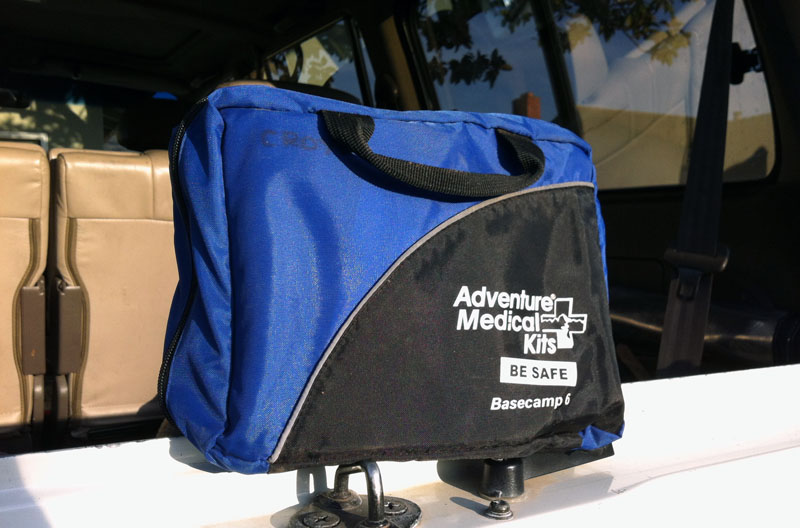First Aid Kit Maintenance

I recently read an article titled “Clean Up, Clear Out For The New Year” by Badlands Offroad Adventures. (Thanks to The 4×4 Podcast for pointing it out!) It was a good article and the first item on their list of things to do was to make or buy a first a first aid kit (FAK), or to do maintenance on your FAK if you already had one.
As soon as I read that, it struck a chord with me. I realized that it had been too long since I’d given proper attention to the FAK I keep in the Land Cruiser. From previous experiences with first aid kits (vehicular or otherwise) I knew that it was important to review and maintain the contents. And sure enough, when I inspected the kit I realized that a few things needed to be replenished.
So, let’s start at the beginning. First, you need to have a FAK. If you’re offroading, exploring, overlanding, whatever, it’s a good idea to have a FAK in your vehicle. It’s not reasonable to expect everyone to bring along a huge and expensive EMT trauma kit, but the contents should support likely incidents such as cuts, minor burns, headaches and so on. Badlands Offroad Adventures also has a solid article on buying/building FAKs so I’m not going to repeat that effort here.
In my case, I purchased a Base Camp 6 kit from Adventure Medical Kits. This model seems to have been replaced by the Mountain Series Weekender in their lineup. I actually have two of these kits (the other stays at home) that I purchased at a massive discount from Steepandcheap back in 2012. You need to use caution when buying a marked-down FAK, because of age and possibly storage issues, but there were no such problems with these.

The Base Camp 6 provided an excellent foundation for my needs, with ample room for expansion. Customizing your FAK to suit your needs (based on activities, users, etc.) is a good idea.For example, my kit supports not only me but my friends who are out hiking with me, my wife, and my daughter (kids = more bandaids and cleaners!)
Based on past experience, I added several packets of meds to mine: more Advil/ibuprofen, Imodium, Tecnu, single-use triple antibiotic ointment packets, etc. I also keep some related items like hand wipes, Purell, and sunblock handy in the passenger area of the Land Cruiser.
Once you’re comfortable with the contents of your kit, hopefully you’re good to go. Just don’t forget about maintaining it over time.
Two major issues of storing anything in your vehicle are vibration (particularly for offroaders) and temperature. The latter can be a big problem in hot weather and can accelerate breakdown of your FAK contents. Meds, protective gloves (especially latex), and some packets seem especially vulnerable to heat damage. I’ve seen latex gloves darken and disintegrate. I had a small bottle of aspirin in my Jeep FAK for a couple of years and the constant vibration had worn every pill down to about half its original size. I’ve also seen packets of liquids (like anti-itch gels) deteriorate and leak their contents, creating a gooey mess.
Replacement or supplemental contents for your FAK can come from many sources, such as from Adventure Medical Kits or other websites, or from stores like REI. It’s a good idea to shop around a bit and see what is available, and what best suits your needs. Sometimes you can get a refill kit of assorted packets that may be ideal for you, or you might be able to save money by simply restocking from a larger and more cost-effective bottle of Advil or whatever that you already have at home. Just remember to always mark expiration dates. Also watch for items that can become contaminated during use, where single-use packs may be preferable.
These issues are a big reason I think it’s important to regularly inspect and maintain my vehicular FAK. Another reason is that certain items like bandaids and Advil tend to get used up more often. Some items I only have one of, so when it gets used I’m out until I replace it. I try to remember to keep these things stocked, but sometimes after a trip it’s easy to forget.
To help me remember to review and take care of my FAK, I now use the same calendar reminder that I set up for topping-up my rechargeable batteries. We use a ton of rechargeable AA/AAA batteries (both at home and when out and about) and while the excellent Eneloop rechargeable batteries I use hold their charge very well over a long period of time (up to 90% remaining after a year), I top them all up every six months. I have the calendar for my Mac (and iPhone) set to remind me on January 1st and July 1st every year. Along with the batteries I now also inspect my FAKs.
Lastly, I want to mention training. Anyone can take an aspirin or apply a bandaid, but I recommend that – at a minimum – you get trained on basic first aid, and preferably CPR. More advanced training is great, but be sure to at least have the basics covered. Your local Red Cross chapter is a good place to start. NOLS WMI offers excellent Wilderness First Aid (WFA) and Wilderness First Responder (WFR) classes, and have recently partnered with REI to offer instruction at more locations around the country.
So keep your first aid kits and your skills up to date, and stay safe out there!